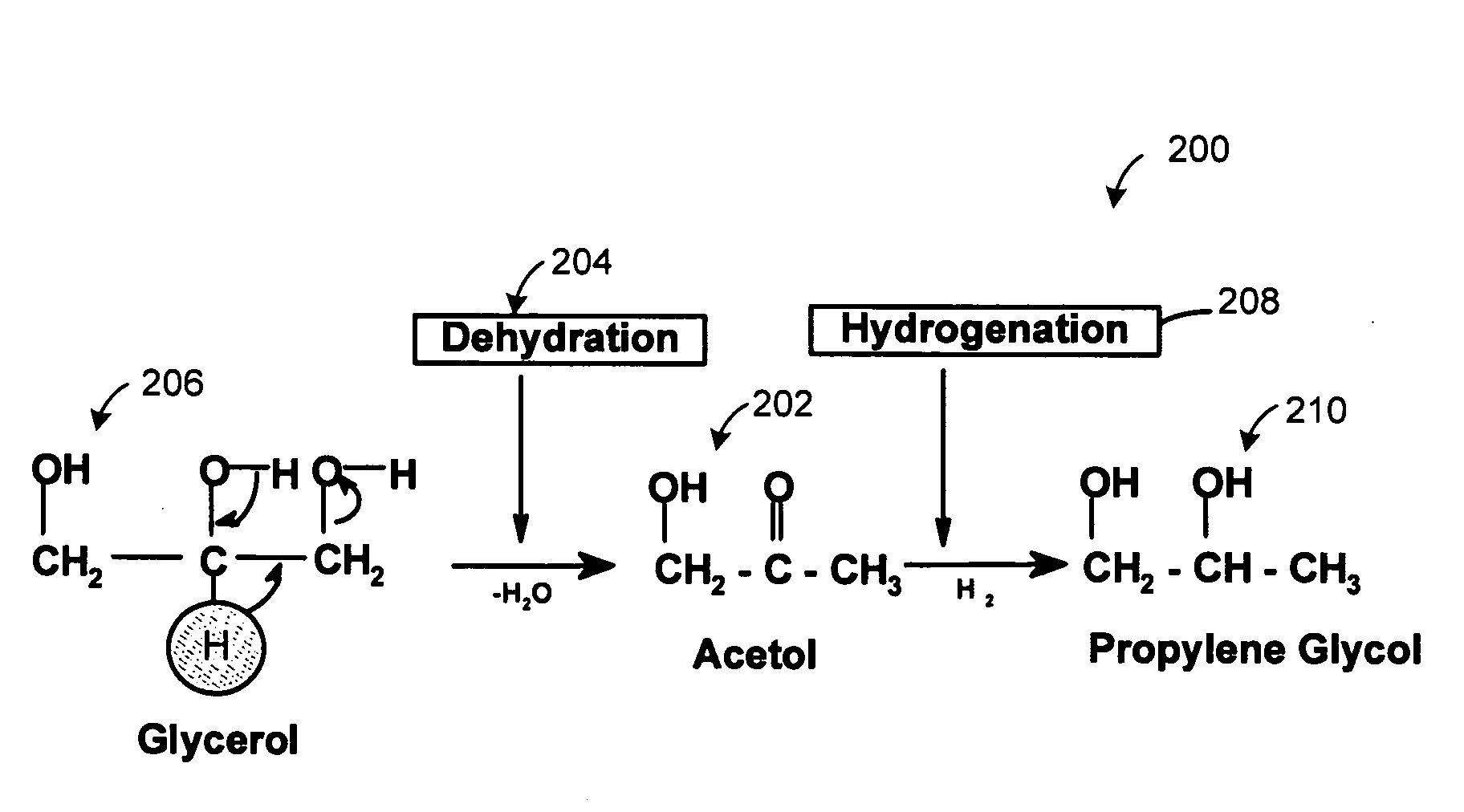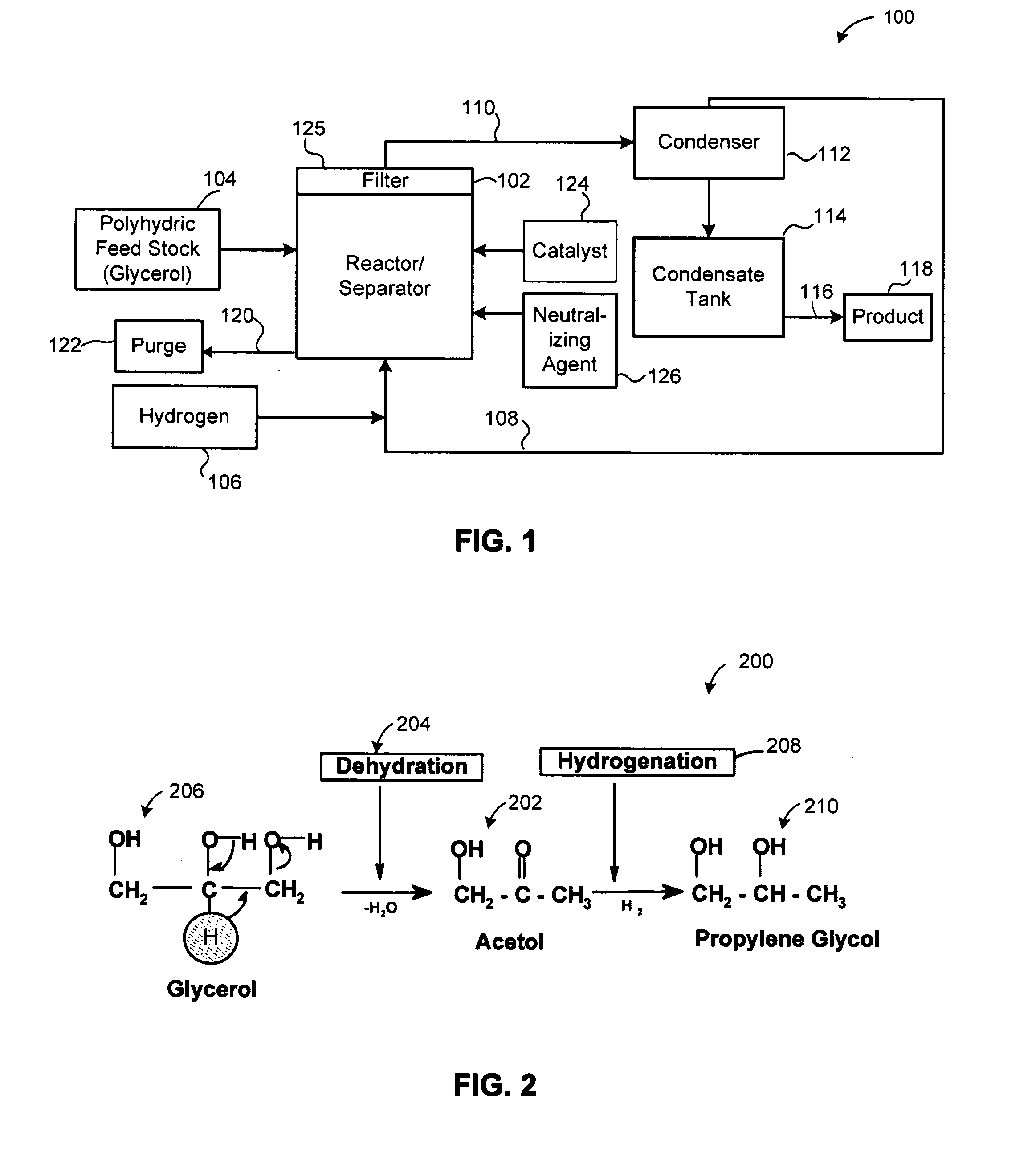Method of producing lower alcohols from glycerol
a technology of glycerol and alcohol, which is applied in the preparation of carbonyl compounds, carbonyl compounds, carbonyl compounds, etc., can solve the problems of excessive high temperature and pressure, increase the capital cost of implementing these processes, and degrade reaction products, etc., and achieves the effect of higher catalyst loading
- Summary
- Abstract
- Description
- Claims
- Application Information
AI Technical Summary
Benefits of technology
Problems solved by technology
Method used
Image
Examples
example 1
Confirmation of Reaction Mechanism
[0058]An experiment was performed to validate the reaction mechanism 200. Reactions were conducted in two steps, namely, Steps 1 and 2. In step 1, relatively pure acetol was isolated from glycerol. Temperature ranged from 150° C. to 250° C. and more specifically from 180° C. to 220° C. There was an absence of hydrogen. Pressure ranged from 1 to 14 psi (6.9 MPa to 96 MPa) more specifically from 5 to 10 psi (34 MPa to 69 MPa). A copper-chromite catalyst was present. In Step 2, the acetol formed in Step 1 was further reacted in presence of hydrogen to form propylene glycol at a temperature ranging from 150° C. to 250° C. and more preferably between 180 to 220° C. Excess hydrogen was added at a hydrogen over pressure between 1 to 25 bars using the same catalyst.
[0059]It was observed in the Step 2 of converting acetol to propylene glycol that lactaldehyde was formed. Propylene glycol is also formed by the hydrogenation 208 of lactaldehyde 302, as illustr...
example 2
Simultaneous Dehydration and Hydrogenation Using Various Catalysts and Reagent Mixtures
[0062]A variety of reaction procedures were performed to show that reaction efficiency may be optimized at any process conditions, such as reaction time, temperature, pressure and flash condition by the selection or choice of catalyst for a given polyhydric feedstock.
[0063]Table 1 reports the results of reacting glycerol in the presence of hydrogen and catalyst to form a mixture containing propylene glycol. The reaction vessel contained 80 grams of refined glycerol, 20 grams of water, 10 grams of catalyst, and a hydrogen overpressure of 200 psig. The reactor was a closed reactor that was topped off with excess hydrogen. The reaction occurred for 24 hours at a temperature of 200° C. All catalysts used in this Example were purchased on commercial order and used in the condition in which they arrived.
TABLE 1Summary of catalyst performances based on 80 gramsof glycerol reported on a 100 grams basis.Ca...
example 3
Packed-Bed Reactor Embodiments
[0083]One method of preparing acetol and propylene glycol from glycerol includes a gas phase reaction at a temperature ranging from 150° to 280° C. in a packed-bed reactor. In some embodiments this temperature is more preferably from 180° C. to 240° C. or 250° C. to avoid thermal degradation of reaction products. The reactions described herein occurred in a packed-bed reactor. The pressures in the reaction vessel are preferably from 0.02 to 25 bars and in some embodiments this pressure is more-preferably between 0.02 and 10 bars. Most preferably, the reaction pressure exists within a range from 0.2 and 1.2 bars.
[0084]FIG. 4 provides a block flow diagram of process equipment 400 including an evaporator 426 for creating a vapor reaction mixture 427. Non-volatile components 428 in the polyhydric feed 104 are removed from the evaporator 426 in a continuous or semi-batch mode. The evaporator 426 is particularly effective for processing crude glycerol that co...
PUM
| Property | Measurement | Unit |
|---|---|---|
| pressure | aaaaa | aaaaa |
| temperature | aaaaa | aaaaa |
| partial pressure | aaaaa | aaaaa |
Abstract
Description
Claims
Application Information
 Login to View More
Login to View More - R&D
- Intellectual Property
- Life Sciences
- Materials
- Tech Scout
- Unparalleled Data Quality
- Higher Quality Content
- 60% Fewer Hallucinations
Browse by: Latest US Patents, China's latest patents, Technical Efficacy Thesaurus, Application Domain, Technology Topic, Popular Technical Reports.
© 2025 PatSnap. All rights reserved.Legal|Privacy policy|Modern Slavery Act Transparency Statement|Sitemap|About US| Contact US: help@patsnap.com



